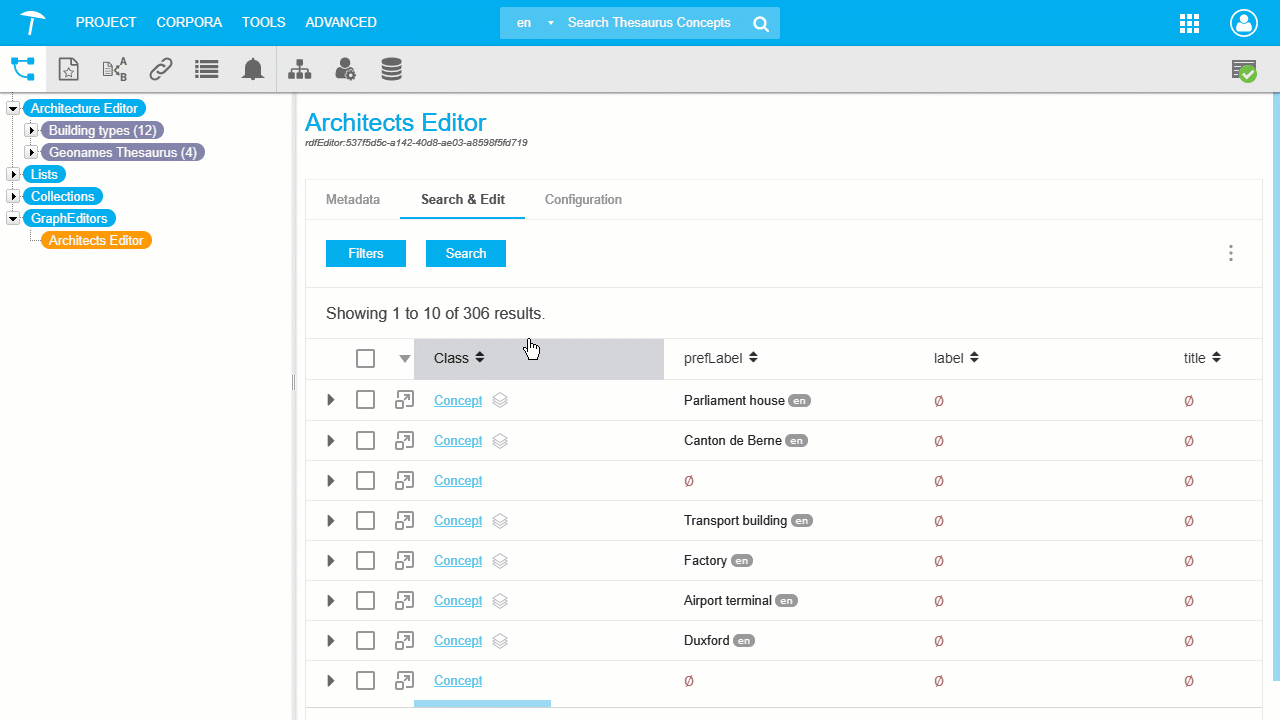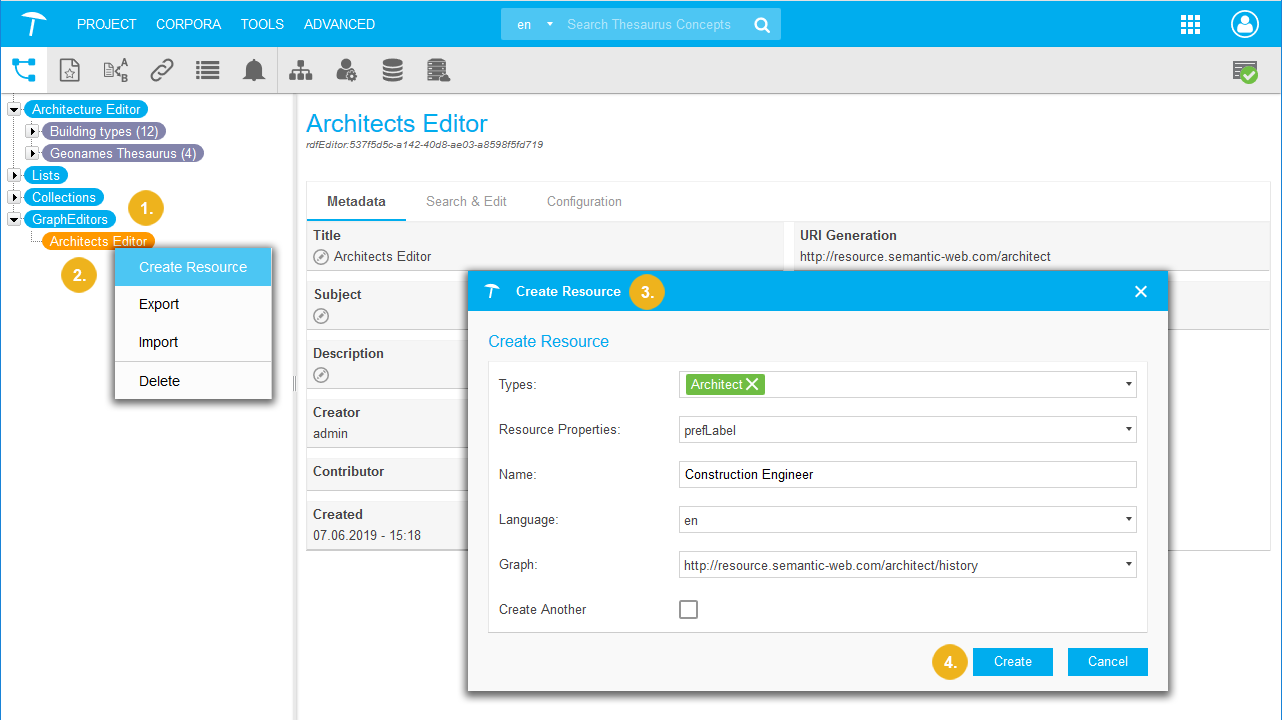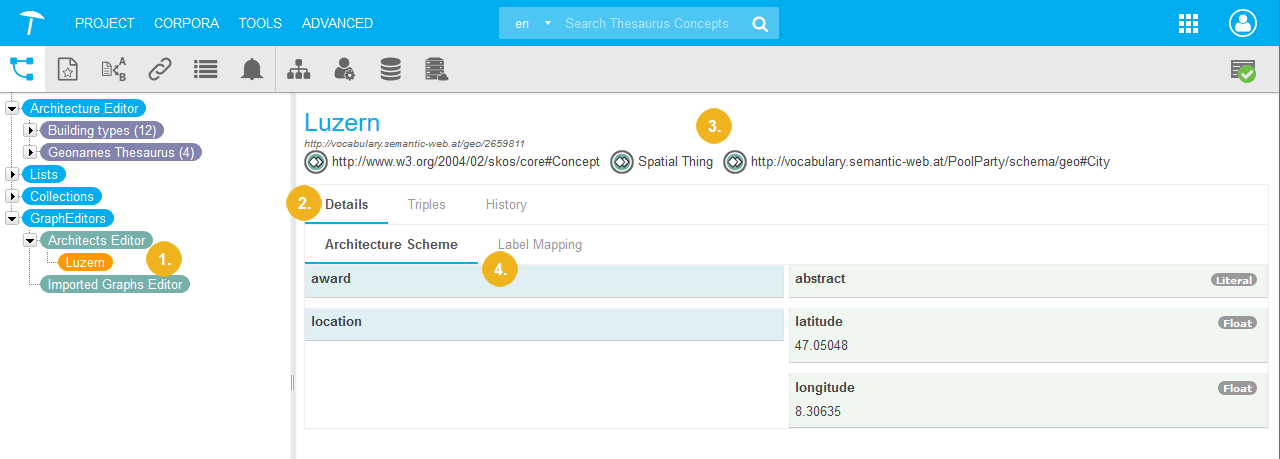GraphEditor - Resource Editing
GraphEditor - Resource Editing
This section contains several guides on how to edit RDF graphs' data resources in PoolParty using the GraphEditor feature.
The data of a custom scheme or thesaurus in PoolParty are stored in RDF format as triples. They are the resources you can work on directly in the RDF format graphs using the graph editors you create for each PoolParty project.
Graph editors are project dependent, therefore, you need to create a PoolParty project first, in order to access the resources you want to edit.
The following topics will guide you through resource editing.
If you want to start editing right away, refer to this section: GraphEditor - Edit Resources in the Search & Edit Tab
GraphEditor - Edit Resources in the Search & Edit Tab
GraphEditor - Edit Resources in the Search & Edit Tab
This section contains a guide on how to edit resources in an existing graph editor.
When you have successfully created a graph editor, you can edit resources inside your RDF data graphs quickly and easily, using the interface as described in this section and the topics listed below. Resource editing is the core feature of the GraphEditor, the design and implementation aimed at giving you full control over every aspect of the RDF-format data. The data, stored on your PoolParty instance and your external graph database that your graph editor is based on.
You can edit resources in several ways inside a graph editor:
The resources you defined by selecting graphs and making them editable will be listed in a table inside the Search & Edit tab.
You can add data to them, change labels and all of this either individually or in a batch operation.
You can also create new relations or attributes for a custom scheme.
In addition, you can open existing resources to access them from inside the Hierachy Tree.
Opening resources in a graph editor's Hierachy Tree makes additional editing and information retrieval easier.
Each graph editor's parent node also offers context-menu items that let you create, import, export and delete resources and graph data.
Find more information in the following topics:
How to Edit Individual Resources
How to Edit Individual Resources
This section contains a short guide on how to edit individual resources in a PoolParty graph editor.
Note
Remember to set the graphs to editable in the Graphs tab, if you want to edit resources. Otherwise they will be greyed out in the table.
After you have accessed your graph editor, follow these steps:
Click the empty space beside the resources link.
The name changes into an editable field.
Change the name to your liking, then click above the table to deactivate the field and save your changes.
 |
How to Edit Resources in a Batch
How to Edit Resources in a Batch
This section contains a short guide on how to edit resources in a batch in a PoolParty graph editor.
Note
Remember to set the graphs to editable in the Graphs tab, if you want to edit resources. Otherwise they will be greyed out in the table.
After you have accessed your graph editor, follow these steps:
Activate one or more resources in the table.
If you want to select all at once, use the check box beside the column headers. That way you can select or deselect all resources.
As shown in the animation below, when you have checked the desired resources, click Add Data to Selected.
The Add Data to Selected dialogue opens.
From the Type drop down choose the facet you want add data for.
Select he Language from the drop down you want to add the data for.
Type the desired value into the Value field and click Add.
Afterwards, expand the resources entries to see the results of your changes.
 |
GraphEditor - Edit Resources in the Hierarchy Tree
GraphEditor - Edit Resources in the Hierarchy Tree
This section contains a short guide on how to use the nodes of individual resources inside a graph editor when they are visible.
Individual resources of a graph editor will be displayed inside its Hierarchy Tree as nodes themselves, once you open them from inside the Search & Edit tab.
They will disappear from view, if you close the graph editor or its containing project. That way the resources will be easily found and will keep the Hierarchy Tree clear.
The following topics will guide you through the available information:
Create a Resource
Create a Resource
This section contains a short guide on how to create a resource in an existing graph editor.
Prerequisite for this step is the successful creation of a graph editor.
In your opened PoolParty project, find the GraphEditors node and expand it.
Find the graph editor below it you want to create the new resource for. Right-click to open the context menu or double-click its node.
The Create Resource dialogue will open.
Enter or select all desired values for your new resource and click Create.
 |
Types: here you can choose from all classes of the custom schemes you added to your graph editor. Mutli-select is possible. You can also choose No Type, but it cannot be used together with any other existing type.
Note
Types here refers to types as defined in the RDF Schema.
Resource Properties: here you can choose the property that the new resource is supposed to have. The following options are available:
prefLabel: the resource will have the property 'prefLabel', the preferred label, as defined in the SKOS schema.
label: the resource will have the property 'label', as defined in the RDF Schema.
title: the resource will have the property 'title', as defined in the Dublin Core Metadata Terms Initiative.
Name: the unique name for your new resource (mandatory).
Language: in this drop down you can choose the language for your new resource.
Graph: here a drop down will let you choose from all editable graphs of your graph editor you want the resource to be stored in.
Create Another: check the check box to re-open this dialogue automatically after creating one, for batch adding resources.
Resource Nodes - How to Display a Node
Resource Nodes - How to Display a Node
This section will guide you through the steps necessary to display graph editor resources inside the Hierarchy Tree.
The Search & Edit tab in a graph editor displays your resources in a table. Apart from editing them there, you can click on their Open icon to open them in a new page.
In order to open the resource's node, follow these steps:
In your opened PoolParty project, find the graph editor of your choice.
Open the Search & Edit tab.
Inside the table, find the resource you want to look at.
Click the Open icon to open the resource in a new page.
The resource will open in a new page, displaying its respective custom scheme's tab inside its Details tab by default.
The node of the resource also will now be visible in the Hierarchy Tree on the left.
 |
Resource Nodes - Configure Resources Inside Their Nodes
Resource Nodes - Configure Resources Inside Their Nodes
This section contains a short guide on the tabs you can see when you open a node you displayed in the Hierarchy Tree of your graph editor.
The resources in a graph editor's Hierarchy Tree will be displayed when you click on their Open icon in the table of the Search & Edit tab of your editor.
The topics in this section will guide you through the editing and configuration options, as well as the label mapping offered here:
Resource Nodes - Details Tab
Resource Nodes - Details Tab
This section contains a short guide on what the Details tab of an opened resource in your graph editor displays.
When you have opened a resource in your graph editor (1), the default tab is the Details tab (2). You will see additional tabs available for opened resources inside of it.
At the top below the resource's name (3), you see similar to other places in PoolParty, such as taxonomies or ontologies, in this case the skos:Concept property as well as the RDF types 'class' and 'subclass' from the respective custom scheme.
Right below the Details tab you will see the custom scheme tab active for that resource, in the example below the Architecture Scheme (4).
 |
Resource Nodes - Custom Scheme Tab
Resource Nodes - Custom Scheme Tab
This section contains a short guide on how the Custom Scheme tab inside an opened resource of your graph editor looks like.
The Details tab (1) of an opened resource opens with its child tab, the Custom Scheme tab (2), by default. You see here in the blue sections on the left (3) the relations of the respective custom scheme, the resource is part of, similar to the Custom Scheme tab of your thesaurus. On the right, in the green sections (4), you find the attributes.
The Custom Scheme tab here will display the name of the custom scheme, since resources you open in your graph editor can belong to different custom schemes.
Note
The image below shows an opened resource whose containing graph has not been set to 'editable'. An editable resource and its description find below.
 |
The image below shows the opened resource 'Luzern' (1), in this case editable. This means, the icons in the sections of the custom scheme's relations (2) and attributes (3) are visible.
 |
The following topic will guide you through the editing steps: Edit an Editable Graph's Resource in the Custom Scheme Tab
Edit an Editable Graph's Resource in the Custom Scheme Tab
Edit an Editable Graph's Resource in the Custom Scheme Tab
Here the same resource as before is opened, 'Luzern'. Since its graph has been set to editable here, more icons and options are available:
in the relations' section, you can use the Link icon (2) to open the Add Resource dialogue.
Start typing to display a drop down with possible resources to choose from.
In the attributes section, you can use the Add icon (3) to add a value according to the data type given, here 'Literal' for the attribute 'abstract'.
Use the Edit icon (4) to open the attribute's Edit dialogue, also depending on the data type defined, in this example 'Float'.
 |
Resource Nodes - Label Mapping Tab
This section contains a short guide on the Label Mapping tab inside an opened resource of your graph editor.
The Label Mapping tab will be displayed in two different ways, editable or non-editable, depending on which graphs you set to editable in the Configuration tab.
You can retrieve information here about the existing label mappings that you can change in the Label Mappings tab of the graph editor itself.
Inside the Details tab (1), you find the Label Mapping (2) tab of an opened resource. In the image below you see the resource 'Luzern' opened (3).
The labels that have been defined and mapped are displayed in the green section on the right (4), together with their values, if any exist.
The data types and language tags of the values are shown as well.
 |
In the image below you see the resource 'Luzern' opened (1).
In the Label Mapping tab (2) on the right the mapped labels are visible (3), this time also showing icons (4) that are common elsewhere in PoolParty.
Use the Edit icon to edit existing values.
Use the Add icon to add more values.
Hover your mouse over the Add icon to display the Delete icon in order to delete values.
Each time the respective dialogue will open to present you with editing fields.
 |
Resource Nodes - How to Delete a Resource Using Its Node
This section contains a short guide on how to delete a resource using its node in the Hierarchy Tree of your PoolParty project.
Note
Using the node of a visible resource in your graph editor to delete a resource from a graph will delete the resource permanently. Use with caution.
The resources contained in an existing graph editor are only visible in the Hierarchy Tree when you open them.
In order to delete a resource, follow these steps:
Find and activate the opened resource in your graph editor's Hierarchy Tree.
Right-click it to open the context menu and select Delete.
PoolParty will display a message asking you to confirm your choice.
 |
Resource Information
Resource Information
Individual resources of an existing graph editor can be displayed inside its Hierarchy Tree. This section provides guides on what information you find there and how to interpret it.
The following topics are available here:
Resource Nodes - History Tab
Resource Nodes - History Tab
This section contains a short guide on what you find in the History tab of an opened resource in your graph editor.
The resources contained in an existing graph editor are only visible in the Hierarchy Tree when you open them.
To access the History tab, in an opened resource's Details View, click on the History tab (1) to open it.
In the History tab of your opened resource you find the following information:
The Overview section (2) contains the following metadata:
Creator: user URI of the user who created the resource.
Creation Date: date the resource was created
Number of Changes: the number of changes the resource went through (integer)
The Latest Changes section (3) will display change data. It displays the following information:
Event Type: PoolParty history event types. Hover your cursor over the icon to learn details of an event.
Resource: the resource's label as also defined in the Label Mapping tab.
Event: short description of the change event.
Date - Time: date and time of the event, format: dd.mm.yyyy - hh:mm
Author: the user name of the user that made the change.
Note
The Latest Changes section will stay empty as long as the resource has not seen any changes.
 |
Resource Nodes - Triples Tab
Resource Nodes - Triples Tab
This section contains a short guide on the Triples tab of an opened resource in your PoolParty graph editor.
The resources contained in an existing graph editor are only visible in the Hierarchy Tree when you open them.
In an opened resource (1), in the Triples tab you see the RDF data triples this resource is part of.
At the top, below the resources preflabel, you see the resource's defining RDF elements, in this case the skos:Concept property as well as the RDF types 'class' and 'subclass' from the respective custom scheme.
In the table below you see the triples similar to the triples display in a concept's Triples tab in the thesaurus.
The first set (2) displays all triples in which the resource is used as a subject. You can see the related predicates and objects.
The second set displays all triples in which the resource is used as an object (3). You can see the related subjects and predicates.
Additionally, you find a column called Graph here (4), which displays the name of the graph this resource is part of.
 |